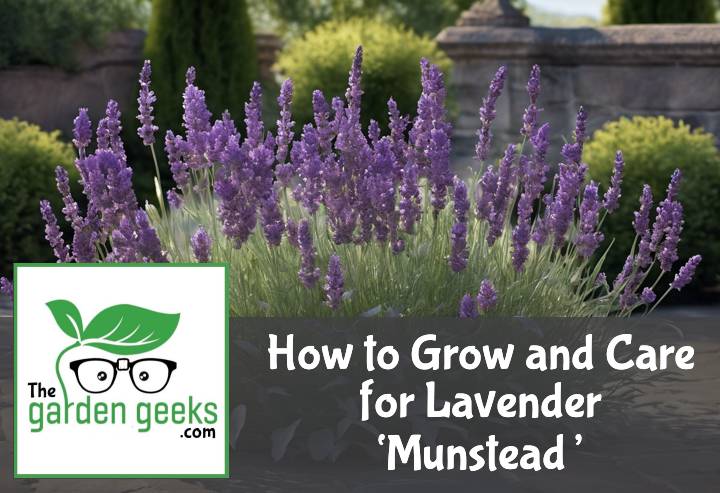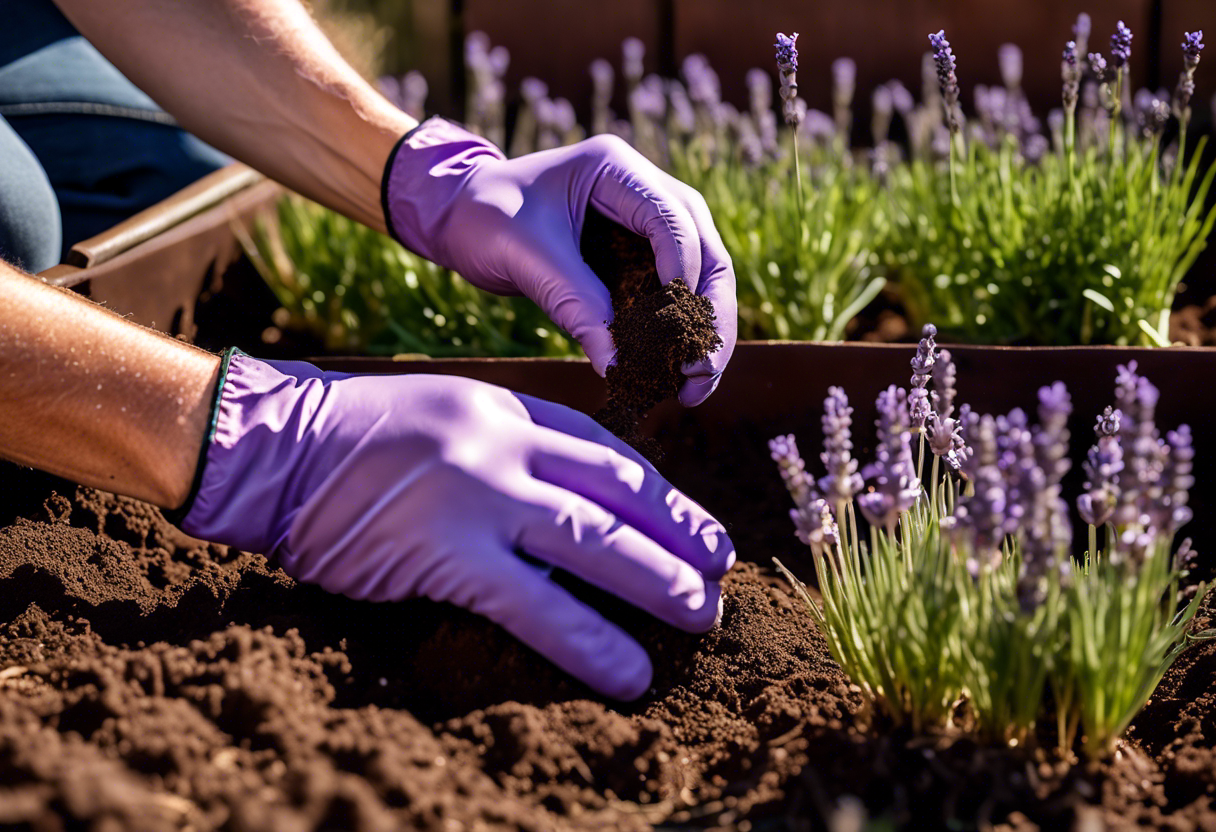Hey there, green thumbs! Ever wondered about How to Grow and Care for Lavender ‘Munstead’? Well, you’re in luck because that’s exactly what we’re digging into today. This isn’t just another plant; it’s a fragrant journey filled with charm and allure.
Now, don’t worry if you’ve never so much as planted a seed before. We’ll break it down Barney-style for you (you know, like the purple dinosaur?). So stay tuned and keep reading about How to Grow and Care for Lavender ‘Munstead’.
Key Takeaways
- Lavender ‘Munstead’ thrives in full sun and well-drained soil, with a pH between 6.7 and 7.3.
- Plant it in spring or early fall, spacing plants 12 to 18 inches apart.
- Water deeply but infrequently, allowing the soil to dry out between watering.
- Prune once a year in late summer after blooming, removing about a third of the plant.
- Protect from harsh winter conditions by mulching around the base of the plant.
- Fertilize sparingly as too much can harm the plant.
What is Lavender ‘Munstead’?
Well, let’s get straight to the point. Lavender ‘Munstead’ is a unique lavender variety that’s got gardeners all over the world buzzing. It’s not your average Joe of aromatic plants, no siree!
Origin and Characteristics
Now, where does this special plant hail from? The geographical origin of Lavender ‘Munstead’ lies in the green pastures of England. Yep, it’s an English lavender variety that has won hearts globally.
Physically speaking, it’s a perennial plant with a charm of its own. This beauty boasts silvery-green foliage and stunning purple flowers that are a sight for sore eyes. And let me tell you, these blooms aren’t just pretty faces; they’re packed with fragrance too!
Benefits and Uses
Growing Lavender ‘Munstead’ isn’t just about adding some color to your garden. Oh no! It offers a whole host of benefits that make it worth every bit of effort.
For starters, its aromatic benefits are off the charts! Just having this plant around can fill your space with soothing scents that can help calm those nerves after a long day.
But wait, there’s more! This versatile lavender variety also has culinary uses. Yep, you heard right! Its flowers can be used to add flavor to dishes or even brewed into a refreshing tea.
And we haven’t even touched on its medicinal properties yet! From helping with sleep issues to easing headaches, this plant is truly nature’s pharmacy in disguise.
How to Plant Lavender ‘Munstead’?
When it comes to how to grow and care for Lavender ‘Munstead’, planting is the first step. And, oh boy, it’s a crucial one! So let’s dig into our Lavender ‘Munstead’ planting guide.
Choosing the Right Location
Now, you might be thinking, “It’s just a plant. Any old spot will do.” But hold your horses! The location is super important when it comes to lavender. This plant loves the sun more than a beach bum in summer. So make sure you choose a spot that gets plenty of sunlight.
And remember, lavender isn’t too picky about soil type but it does prefer well-drained soil. So if your garden turns into a swamp every time it rains, that might not be the best location for lavender.
Preparing the Soil
Alrighty then! You’ve found the perfect spot for your lavender. Now let’s talk dirt… literally! Soil preparation for lavender is key to ensure your plants thrive.
First things first: check your soil pH level. Lavender likes slightly alkaline soil with a pH between 6.7 and 7.3. If your soil is more acidic, don’t panic! Just add some lime to balance things out.
Next up: drainage. Remember how we said lavender doesn’t like wet feet? Well, improving soil drainage for lavender can help prevent waterlogging and root rot.
Planting Process
Okay folks, now we’re getting down to business: the actual planting process of our beloved Lavender ‘Munstead’. First off, grab your shovel and start digging holes about 12 inches deep and 18 inches apart – this gives each plant enough room to grow without crowding its neighbors.
Once you’ve got your holes dug, pop your lavender plants in, making sure the top of the root ball is level with the soil surface. Then, backfill the hole with soil, firming it gently around the plant.
And finally, give your newly planted lavenders a good drink of water. But remember, don’t overdo it! Lavender prefers to be a bit on the dry side. So there you have it folks: how to plant Lavender ‘Munstead’ in a nutshell!
How to Care for Lavender ‘Munstead’?
When it comes to Lavender ‘Munstead’ care, there are a few key things to keep in mind. It’s all about the right balance of watering, fertilizing, and pruning. So let’s dive into the nitty-gritty of maintaining lavender plants.
Watering Requirements
First up, let’s talk about watering lavender plants. You see, Lavender ‘Munstead’ isn’t too fussy when it comes to hydration. They’re pretty drought-tolerant once established.
However, during their first growing season, they’ll need regular watering. But don’t go overboard! Overwatering can lead to root rot which is a big no-no for these guys.
The Lavender ‘Munstead’ watering needs can vary depending on factors like climate and soil type. If you’re in a hotter climate or have sandy soil, you might need to water more frequently.
Fertilizing Needs
Next up on our Lavender ‘Munstead’ care guide is fertilizing. Now, these plants aren’t heavy feeders so you won’t need to fertilize often.
But when you do, opt for a slow-release fertilizer with low nitrogen content. Why? Well, too much nitrogen can lead to leggy growth and fewer flowers – not what we want!
Remember that timing is everything when it comes to fertilizing lavender plants. The best time is early spring as new growth begins.
Pruning Techniques
Last but certainly not least in our guide on how to care for Lavender ‘Munstead’ is pruning. Regular pruning helps maintain plant health and promotes bushier growth – win-win!
Pruning should be done in early spring or late summer after flowering has finished. And don’t be shy – these plants can handle a good trim!
So there you have it – the basics of Lavender ‘Munstead’ care. Remember, every plant is unique and might need a little extra love and attention. But with these tips, your lavender plants will be thriving in no time!
Common Problems in Growing Lavender ‘Munstead’ and Their Solutions
Growing lavender ‘Munstead’ can be a bit tricky. You might encounter some lavender ‘Munstead’ problems that could leave you scratching your head. But don’t worry, we’ve got your back! Let’s dive into the common issues and their solutions.
Pest and Disease Management
First up, let’s talk about pests and diseases. Lavender pests are a real pain, aren’t they? You might find aphids or spittlebugs feasting on your precious lavender. Not to mention the diseases like root rot or fungal infections that could creep in.
But fear not! Managing lavender diseases is not as daunting as it sounds. Regular inspection of your plants can help you spot these invaders early on. And if you do find them, using organic pesticides or fungicides usually does the trick.
Also, did you know there are disease-resistant lavender varieties? Yep, choosing one of these could save you a lot of hassle down the line!
Overwatering and Underwatering Issues
Now let’s move on to watering issues. Lavenders are pretty drought-tolerant but that doesn’t mean they don’t need water at all! If you notice wilting leaves or stunted growth, those might be signs of an underwatered lavender plant.
On the flip side, overwatering can also be harmful. Yellowing leaves or root rot are typical overwatered lavender symptoms. The key here is balance – lavenders like well-drained soil so make sure not to drown them!
Remember folks, learning how to grow and care for Lavender ‘Munstead’ is all about understanding its needs and responding accordingly. So keep an eye out for these issues and happy gardening!
Harvesting and Storing Lavender ‘Munstead’
Harvesting and storing Lavender ‘Munstead’ is a piece of cake once you know the ropes. It’s all about timing, care, and a bit of love for your lavender plants.
When to Harvest
The best time to harvest lavender? Well, it’s when those lovely flowers are just about to open fully. That’s when they’re at their most fragrant. You want to catch them in their prime, like an A-list celebrity on the red carpet.
Weather conditions also play a part in deciding when to pick lavender. Dry, sunny days are perfect for harvesting as moisture can lead to moldy blooms – yuck! So keep an eye on the sky as well as your plants.
One more thing: early morning or late evening is the ideal time of day for harvesting lavender flowers. Why? Because that’s when the essential oils are at their peak. And we all want our lavender smelling its best, right?
How to Store
Now let’s talk about storing this purple beauty. After you’ve harvested your Lavender ‘Munstead’, it’s important to store it properly so it doesn’t lose its charm.
First off, make sure your lavender is completely dry before storing – remember what we said about moisture and mold? Yeah, not a good mix. If you’re preserving fresh flowers, hang them upside down in a dark place until they’re dry.
When it comes to dried lavender storage, keep it in an airtight container away from light and heat. This will help maintain its quality and longevity.
And there you have it! With these tips on harvesting and storing, your Lavender ‘Munstead’ will be looking (and smelling) fabulous for longer.
To Wrap Up
Like a trusty friend, Lavender ‘Munstead’ doesn’t ask for much – just some sunshine, well-drained soil, and a little pruning love. So don’t be shy; get your green thumbs dirty! Check out How to Grow and Care for Lavender ‘Munstead’ for more tips.
Remember, growing this lavender is like baking a cake – follow the recipe, add a pinch of patience, and you’ll have a garden masterpiece. Happy gardening!





